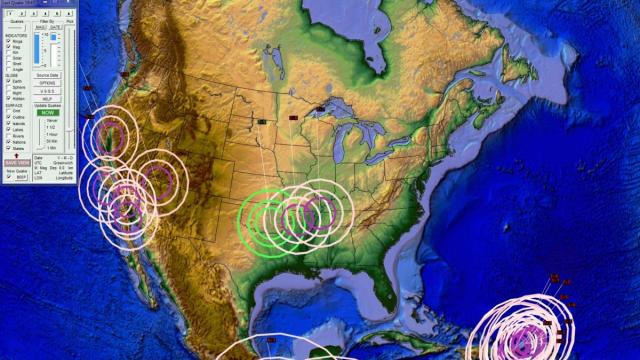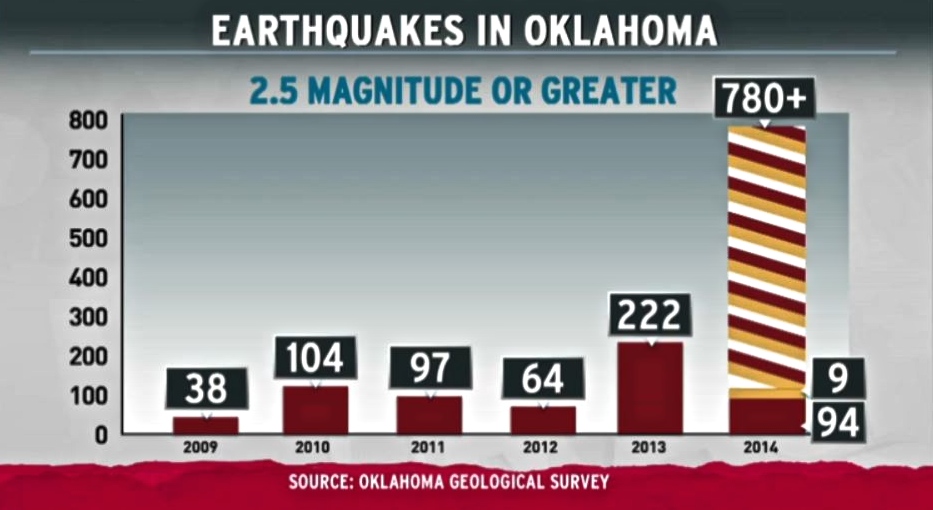
In the last week alone, residents of Guthrie, pop. 10,191, have felt five quakes rock the town a half hour's drive from Oklahoma City.
The most recent rippled through Friday after lunchtime, duly recorded on the "QuakeWatch" application many residents have loaded onto their smartphones. The local newspaper runs a weekly column updating details of the latest quakes.
"It feels like the earth is opening up and you are falling," said one resident, Boxley. "It's scary."
Since January, Oklahoma has had 292 earthquakes that register a magnitude 3.0 or larger, more than any other state in the continental United States. That's nearly triple the 109 last year. Through 2008, Oklahoma averaged less than two a year.
The unprecedented earthquake activity has put Oklahoma in the center of an emerging debate over whether the disposal of wastewater from oil and gas production triggers earthquakes. It has prompted enactment of broad new rules that go into effect Sept. 12.
"The houses are bouncing. It is frightening," said Matt Skinner, spokesman for the Oklahoma Corporations Commission, which regulates oil and gas work in Oklahoma. Skinner's home itself has suffered quake damage.
Oklahoma's economy relies heavily on oil and gas. Seventy of Oklahoma's 77 counties produce crude oil and gas, and 4,500 disposal wells around the state handle the industry's wastewater. Scientific studies have shown wastewater activity may cause quakes when occurring near geologic faults.
Regulators say they do not know if disposal wells, which can reach thousands of feet underground, are to blame for the sharp rise in earthquake activity. As a precaution, they are scrambling to scrutinize every well, and even shutting some down.
"We are looking at these wells and going over them with a fine-tooth comb... looking for anything that might trigger seismicity," Skinner said. "We can't leave anything to chance because something is happening here that no one understands."
The rules taking effect next month require well operators to make daily reports on volume and pressure of wastewater injection instead of monthly reports, as previously required.
Many wells must have seismic monitoring equipment, and testing of certain large disposal wells now must take place annually, instead of every five years. Regulators also can require testing of any well, large or small, at any given time.
Regulators are deploying inspectors to wells and monitoring whether pressure and volumes of wastewater injections are within regulatory limits. So far this year, regulators temporarily shut down at least 10 wells. One remains closed.
"If a well has a minor infraction or anomaly, it is no longer minor. They are shut in until they are fixed," said Skinner.
While the state increases scrutiny, action in the courts already has begun. On Aug. 4, a woman from Prague, Oklahoma, sued New Dominion LLC and Spess Oil Co., blaming them for injuries she suffered when a fireplace in her home broke apart in a series of earthquakes magnitude 5.0 and larger that struck Prague in November 2011.
A spokesperson for Spess declined comment on the lawsuit, and New Dominion did not respond to interview requests.
The Oklahoma Independent Petroleum Association and the Oklahoma Oil & Gas Association said they are working with regulators and researchers to gather and analyze data, and are not ready to say what they believe is causing the earthquake increase.
"We remain committed to finding answers based on sound science," said OKOGA President Chad Warmington. As part of the probe, the Oklahoma Geological Survey is cross-referencing quake data with well data and installing seismic monitoring equipment around the state.
Guthrie and nearby communities are top hot spots because they have seen a concentration of seismic activity.
The quake that hit Friday registered 3.2 magnitude and rattled the 188-bed county jail in Guthrie. The jail also was hit in February, said Logan County Deputy Richard Stephens.
"It felt like a bus hit the station," he said.
3 WAYS TO SHOW YOUR SUPPORT
- Log in to post comments












